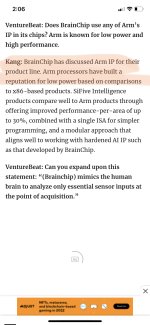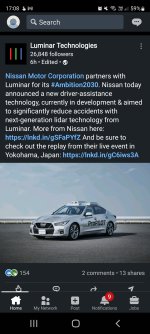BrainChip Holdings (ASX: BRN) has inked a deal to integrate its AI-powered BrainChip Studio with NASDAQ-listed Veritone’s aiWARE platform.

smallcaps.com.au
Veritone Launches Veriverse, a Portfolio of Integrated AI Solutions for Content IP Owners and Individuals Leveraging the Metaverse, NFTs and Blockchain
AI/MLANALYTICS
 By Business Wire
By Business Wire On Apr 19, 2022

Share
Veriverse to empower customers, rights holders and influencers with the ability to leverage metaverse-ready solutions to create new revenue channels at scale
Veritone, Inc., creator of aiWARE™, a hyper-expansive enterprise AI platform, today announced the launch of a series of proven AI solutions to open up new distribution, commerce, and revenue opportunities for today’s content IP owners and individuals across multiple digital communities, including the metaverse. Veriverse™ offers a path forward in both traditional media channels and immersive environments to securely create and activate synthetic media, protect and manage identity and assets, maintain brand continuity across channels and safely create and sell NFTs.
Marketing Technology News: Why Some Small Businesses Don’t Use Websites
Citi is the latest banking giant to call the metaverse and Web3 a multi-trillion dollar opportunity. In its March 2022 report, “
Metaverse and Money: Decrypting the Future,” Citi said the metaverse economy could be an $8 to $13 trillion total addressable market by 2030. In research published in December 2021, Goldman Sachs put a $12.5 trillion number on the space, in a bullish outlook that assumed one-third of the digital economy shifts into virtual worlds and then expands by 25 percent. Furthermore, a Gartner® report states, “the metaverse will provide economic opportunities using new kinds of digital business assets and value exchange models. Executive leaders should augment their digital transformation strategy by exploring virtual world product development, brand placement, customer engagement, and financial flows.” (Gartner,
“How to Increase Customer Engagement and Drive Revenue in the Metaverse”, David Furlonger, Christophe Uzureau, Rajesh Kandaswamy, Feb 8, 2022).
With specific solutions that operate in traditional channels and the metaverse, Veriverse includes:
- Veritone Voice
- Veritone Avatar
- Veritone NFT
- Veritone Verify
- Veritone Metaverse Migration Services
“Disparate metaverses already exist, signaling the emergence of Web3, an extremely fast-growing yet decentralized and disruptive opportunity, and content IP owners and influencers need to be fully enabled to make that transition without sacrificing their brand security, personality and attributes. Veritone is a trusted partner of the largest rights holders in the world and has unmatched expertise in artificial intelligence––including synthetic media, media workflows, advertising and content licensing. We are well positioned to help our current and future customers make the move to, and excel within, the metaverse,” said Ryan Steelberg, President and co-founder of Veritone.
Marketing Technology News:ForAllSecure Launches $2 Million Mayhem Heroes Program to…
Veritone Voice™ is an AI-enabled custom synthetic voice cloning solution that allows users to securely and ethically create and monetize synthetic voices in real or digitally immersive worlds by acquiring the necessary training data to create a custom voice that can be transformed into different languages, dialects, accents, genders and more.
“Veritone Voice will streamline the way we work with talent in film and TV production, while still creating authentic experiences for audiences,” said Amani Martin, Emmy award-winning director and producer and Managing Partner of Vin Scully Digital.
With Veritone Avatar™, users can create avatars for a broad range of use cases, including advertising, recruiting, patient care, eLearning and customer service.
“What audiences crave in these metaverse experiences is, ironically, human connection,” says Beau Romero, YouTube Influencer, Us Always member. “Bringing such realistic and lifelike avatars to immersive experiences is something I am very passionate about for the next evolution of my brand.”
Veritone NFT™ is a smart contract-enabled NFT minting and marketplace solution for audio, images, and video, including a proprietary minting service exclusive for Veritone clients. The Veritone NFT Marketplace enables approved users to create, buy and sell NFTs.
Veritone Verify™ is a powerful digital security system that provides content owners a way to manage and protect their identity and IP in both traditional channels and digitally immersive worlds. The solution also enables brand continuity and ensures their assets will be licensed and monetized within a centralized ecosystem.
“Individuals who create and own media have a critical need for cohesive solutions that combine content management, IP protection and monetization across real and digital immersive worlds,” Brett Kollmann, YouTube Influencer, Creator and Host of The Film Room. “I’m most excited about ensuring brand continuity while protecting my identity and assets as we create and share content in different ways, including in the metaverse.”
With Veritone Metaverse Migration Services, our industry experts guide companies of all sizes to assess their readiness, map a plan to enter the metaverse, ensure proper licensing of owned content in a metaverse world, establish activation for virtual shopping experiences, VIP events, exclusive engagements, product promotions, or new digital NFTs, and test and scale their migration.
“We are active users of the Veritone Digital Media Hub solution to manage our deep bench of 80+ years of video assets on and off the field,” said Paul Hodges, VP of content and entertainment, San Francisco Giants Productions. “When we partnered with Veritone back in 2020, we liked that the AI solution was future-proofed by being cloud and model agnostic. Today, we are seeing a path forward to engaging our fans in the metaverse because of our legacy investment and partnership with Veritone.”
Some interesting language used that raises a possibility of a continuing relationship.
My opinion and speculation only so DYOR
FF
AKIDA BALLISTA



 By Business Wire
By Business Wire




